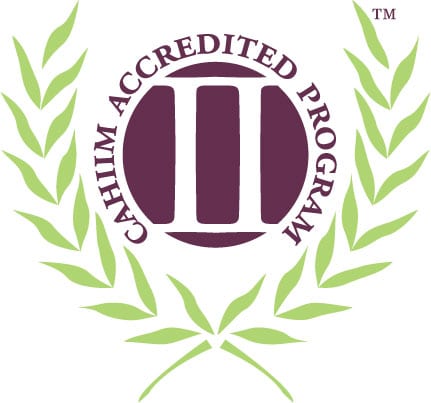
Specialization in this in-demand field is on the rise. Are you an RN, LPN, RHIT, RHIA or CCS, CCS-P, CPC, CIC, COC, CPMA? Clinical Documentation Improvement uses your skills in medical coding, clinical care and health record documentation. This Certificate’s curriculum covers the CDIP exam domains and will prepare students for taking the CDIP exam. Note that the CDIP exam requires an associate's degree or higher or a CCS, CCS-P, RHIT, or RHIA credential.

Charter Oak’s Clinical Documentation Improvement Certificate program is accredited by the Commission on Accreditation for Health Informatics and Information Management Education (CAHIIM®). All inquiries about the program’s accreditation status should be directed by mail to CAHIIM®, 200 East Randolph Street, Suite 5100, Chicago, IL, 60601; by phone at (312) 235-3255; or by email at info@cahiim.org.
The CDIP credentialing exam is offered by AHIMA and students are responsible for reviewing the CDIP exam requirements.
Acceptance into this program requires an associate's degree or one of the following credentials: RHIA, RHIT, RN, LPN, CCS, CCS-P, CPC, CIC, COC, CPMA or with special permission from the Health Sciences and Technology Program Associate. This certificate equips students with a working knowledge of clinical documentation improvement (CDI) tasks, procedures, policies, philosophy, and value. A focus will be placed on mastering documentation concepts as it relates to reimbursement and medical necessity. Courses will immerse students in real-world scenarios and processes, giving the student experience that simulates work experience in the field. A case study practicum is the final course and will require students to demonstrate high-level CDI knowledge and skills.
BIO 212 Anatomy and Physiology
3 creditsBIO 215 Pathophysiology
3 creditsHCA 105 Medical Terminology
3 creditsHIM 205 Reimbursement Methodologies
3 creditsHIM 210 Clinical Classification Systems I
3 creditsHIM 211 Clinical Classification Systems II
3 credits
This Certificate is 33 credits and 15 of these credits must be completed at Charter Oak. All courses must be completed with a grade of 'C' or better.
HIM 371 Revenue Cycle and CDI
3 creditsHIM 373 CDI Operational Process
3 creditsHIM 475 Compliance and Medical Necessity
3 creditsHIM 477 Mastering Documentation
3 creditsHIM 491 CDI Case Study Practicum
3 creditsTotal
33 credits
Outcomes & Pathways
Students who complete a certificate in Clinical Documentation Improvement will be able to:
- analyze coded diagnoses and procedures related to reimbursement methodologies and billing;
- analyze patient health records in the current EHR environment for documentation that meets accepted coding guidelines;
- query physicians for documentation clarification and interpretation;
- identify ethical, legal, and compliance issues as they relate to documentation, coding and reimbursement;
- evaluate the relationship between financials and clinical documentation that drives the operational revenue cycle performance;
- utilize the principles of chart review and clinical documentation improvement tools within the EHR;
- relate medical necessity to the criteria for quality documentation and communication of patient care and bidirectional clinical indicators;
- demonstrate the ability to communicate, interact, and engage providers in the standards of documentation as an integral part of the practice of medicine.
Question: How do I redeem my qualified credential(s) for undergraduate and/or graduate college credit with Charter Oak?
Answer: Tell us which credentials/certifications you’ve earned when you apply along with your member ID. We’ll do the rest. View the full list of evaluated professional credentials for credit.
- Certified Coding Associate (CCA) up to 20
- Certified Coding Specialist (CCS) up to 23
- Certified Documentation Improvement Practitioner (CDIP) up to 19
- Certified Inpatient Coder (CIC) up to 17
- Certified Clinical Medical Assistant (CMA) up to 10
- Certified Nurse Aide (CNA) up to 4
- Neurophysiologic Intraoperative Monitoring (CNIM) up to 35
- Certified Outpatient Coder (COC) up to 23
- Certified Professional Biller (CPB) up to 9
- Certified Professional Coder (CPC) up to 19
- Certified Professional Compliance Officer (CPCO) up to 23
- Health Information and Management Systems, Certified Professional (CPHIMS) up to 9
- Certified Professional Medical Auditor (CPMA) up to 25
- Certified Phlebotomy Technologist (CPT) up to 4
- Risk Adjustment Coder (CRC) up to 23
- Clinical Research Coordinator (CRC) up to 29
- Emergency Medical Services Responder (EMR) up to 2
- Emergency Medical Services Technician (EMT) up to 6
- Emergency Medical Services Technician, Advanced (EMT-A) up to 8
- Health Services Executive (HSE)* up to 19
- Nurse, Licensed Practical (LPN) up to 16
- Magnetic Resonance Imaging technician (MRIT) up to 16
- Registered Behavioral Technician (RBT) up to 3
- Registered Electroencephalographic Technologist (RET) up to 19
- Registered Health Information Administrator (RHIA) up to 48
- Registered Health Information Technician (RHIT) up to 37
- Registered Medical Assistant (RMA) up to 24
- Nurse, Registered (RN) up to 64
- Radiologic Technologist (RT) up to 33
- Paramedic up to 41
*Approved for Graduate level.
Why Charter Oak State College?
- 100% online
- Credit for credentials
- Six (6) start dates
- Expert Faculty
